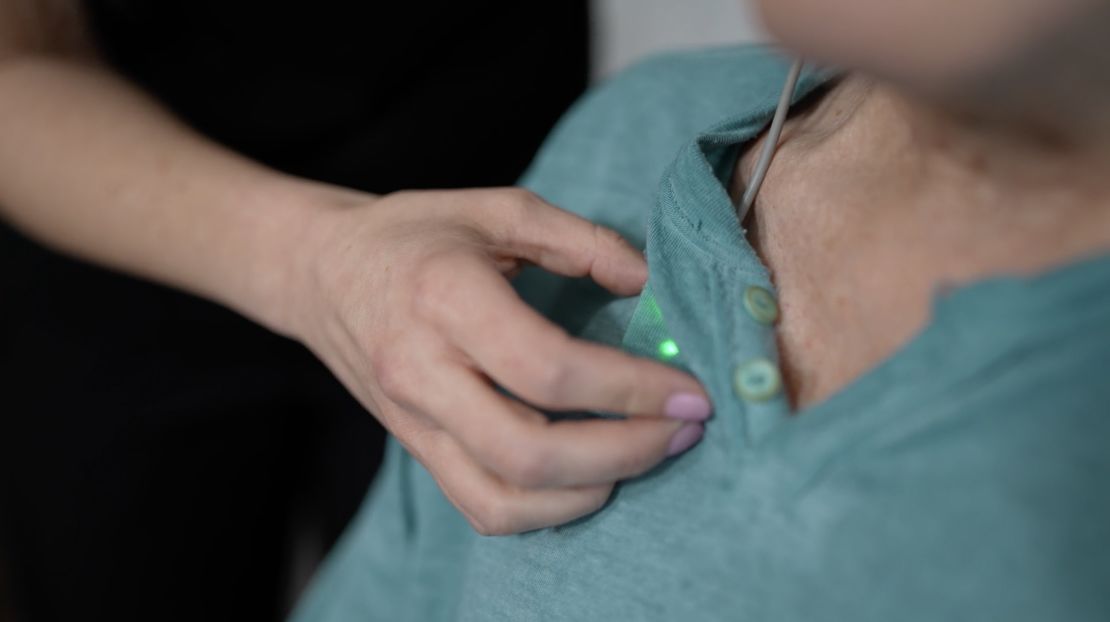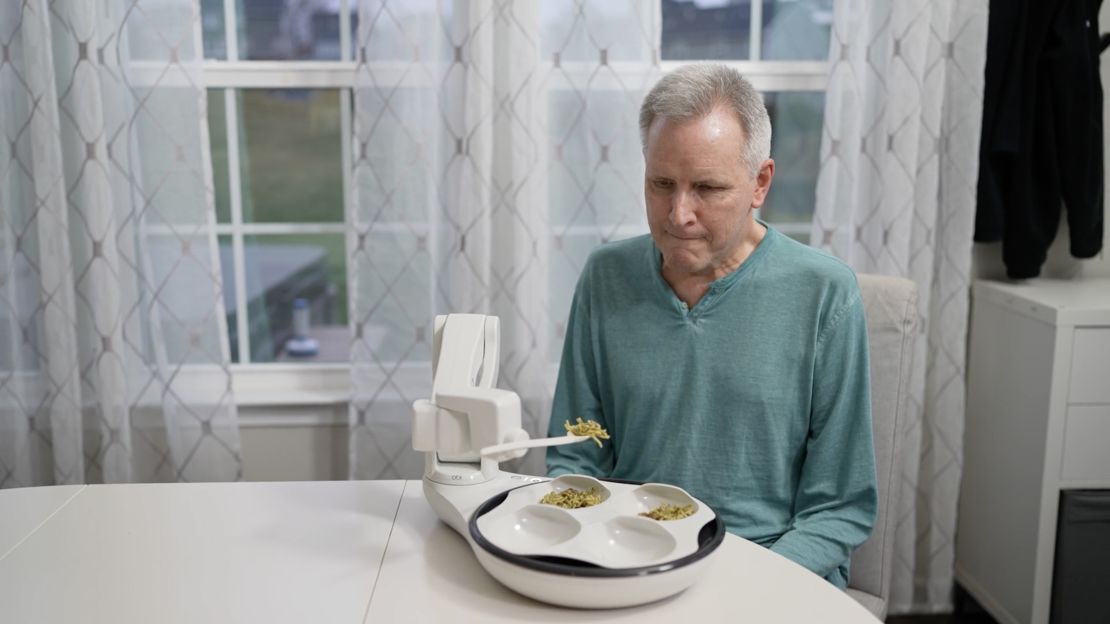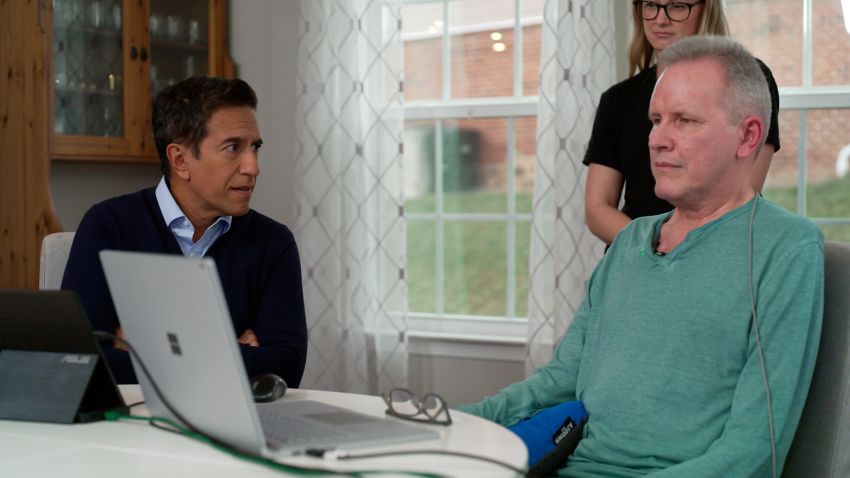Staring at a computer screen, Mark focuses deeply, his arms resting by his side. His right index finger trembles ever so slightly on top of a pillow, and then an alert rings out from the screen in front of him, a message to a caregiver that he needs assistance.
Without ever clicking a mouse or touching a screen, Mark selected this command on his computer simply using signals from his brain. Mark, whom CNN agreed to identify using only his first name for privacy reasons, has an implant inside his brain that is translating his neural activity to commands on a computer.
Mark is only the 10th person in the world implanted with this particular type of brain-computer interface, or BCI. He’s participating in a human trial with a company called Synchron and underwent the procedure in August, after being diagnosed with amyotrophic lateral sclerosis – sometimes called ALS or Lou Gehrig’s disease – in 2021.
The hope is that the technology in Mark’s brain could assist him and others like him who are losing their motor function. “It’s an opportunity for a piece of technology to help someone that will not be able to help themselves otherwise,” Mark told CNN.
Excitement around the potential for BCI technology has mounted over the past year, propelled in part by high-profile support from billionaire Elon Musk via his company Neuralink, as well as the recent publication of several promising studies from other players in the growing field.
But the technology is far from mainstream, and efforts to commercialize it remain fraught with regulatory hurdles, ethics and privacy concerns. And the emerging technology itself faces numerous limitations. In other words, these procedures won’t be coming to your local doctor’s office anytime soon.
Still, Mark says the opportunity to be at the forefront of testing this technology that could help others was important to him. Knowing that there is no cure for ALS, Mark says, signing up for the trial felt like a “no-brainer” to him.
“I figured I had two choices: I could wallow in self-pity, or I could pick myself up by the bootstraps and do what I could to help,” Mark said.
Creating a dictionary of the mind
Relaxed and dressed in a light teal sweater, Mark offers no obvious physical indications that he has a BCI. He says he doesn’t notice it, either.
“I have no sensation in my brain, that there’s something there,” he told CNN’s Chief Medical Correspondent Dr. Sanjay Gupta in an interview.
Mark has two small scars, one on his right chest and one on his neck, but no other visible indicators of a BCI.
Synchron’s brain implant, the one Mark has, is called a Stentrode and consists of a stent with electrode sensors that can detect electrical brain activity. Synchron patented the Stentrode, and the company was the first to receive approval from the US Food and Drug Administration to begin human trials for permanently implantable BCIs.
Like a normal stent, it doesn’t require open brain surgery. Instead, it’s able to travel through the body’s natural network of veins, so the entry point was Mark’s jugular vein. His surgeon threaded the device through the blood vessels all the way to the top of his brain, where it sits in the sagittal sinus, one of the brain’s main veins, cradled in the motor cortex, the part of the brain responsible for movement.
Whether it’s shaking hands or taking a step, every action a person does is associated with a specific electrical signature from their brainwaves. The Stentrode learns to recognize those electrical patterns and creates a personalized dictionary of movement.
There may be a general electrical signature for different movements, but each person’s will vary slightly, making the device highly personalized.
When Mark thinks about a certain movement, like clicking somewhere on a computer screen, the Stentrode reads that brain signal and recognizes the intended movement. Then that message travels via a very thin cable to an internal transmitter, similar to a pacemaker, that was surgically implanted in his chest.

So much data travels from Mark’s brain to the transmitter that it has to be wired to a computer. That external transmitter sits right above the internal transmitter and carries the signal from Mark’s brain to the computer almost instantaneously. At the moment, Mark has to be wired to the computer to use the device.
However, the goal is that the next-generation devices will eventually have a wireless process, so a patient would need only the Stentrode and the transmitter inside the chest.
Coming to terms with an ALS diagnosis
Mark first noticed that something wasn’t quite right in 2020. He couldn’t snap his fingers or make a pinching motion with his left hand; he also noticed some visible muscle atrophy. “And then I dropped a cup of coffee,” he recalls.
At age 63, Mark’s diagnosis was official: He had ALS, a disease with which most people are only expected to live three to five years after symptoms develop.
“It was a hard pill to swallow,” he admits. “I still consider myself young.”
He had a job he loved and was going to retire soon. He also has a family, including two daughters and one granddaughter.
Despite the diagnosis and weakness in his arm, Mark continued to work at his job at a wholesale floral company. Lifting buckets of water and boxes of flowers, however, soon became too difficult. Then driving became difficult. By December 2022, he stopped driving altogether.
There was an emotional toll to ALS too as Mark started to lose his independence. “I lived alone for 13 years, so I was used to doing everything by myself,” he said.
He eventually moved in with his brother and his brother’s family. Today, his voice is strong, and he can still walk, but he says he has to use a foot-controlled feeder to eat because of the loss of strength in his arms.
Mark is still able to make some very limited movements with his hands, but he’s lost most of the dexterity in his fingers – meaning he can’t pick up a pencil or scroll on his phone. Mark hopes the BCI can help him with tasks like accessing his phone.
But Mark didn’t lose hope that he could still find a way to help others. He enrolled in a drug trial, and when that ended, he immediately asked his doctor what else he could do that was “new and exciting.”
That’s when he found himself in this feasibility trial with Synchron and the BCI.
After his device was implanted in August, his ability to use his BCI wasn’t immediate, something that frustrated him. It took about two months for his recovery, including waiting for the swelling from the pacemaker-like device to go down, before the Synchron team could even turn the implant on. But he remembers the first time it did work.
“There was a few cheers,” he recalls. “We’d been trying and trying, and it was not working so good, and then it finally worked.”
For the past three months, Mark has been working with Maria Nardozzi, an occupational therapist from Synchron. As he masters each task, he builds up that dictionary of movement that the device uses to read his brainwaves and translate them into actions on the computer. So far, Mark has mastered a program that allows him to send a health notification or a pain report to his provider if needed. His immediate goals are to be able to control his Alexa and turn on Netflix, as well as to learn how to text.
“Text messaging is a really critical element of how we communicate with our family and friends now,” said Stentrode developer Dr. Tom Oxley, the CEO of Synchron. “So that’s usually what people mostly want back.”
Oxley said he has seen some patients with stentrodes able to type between five and 10 words per minute already, a notable achievement if you consider that most people can text between five and 20 words per minute.
Mark has also used the device to play a “Pong”-like table tennis video game. He describes the feeling of using the device as his brainwaves contracting and then relaxing. Each move he wants to make on the computer has a focused, intentional thought. If he doesn’t want the bar to move, he must relax.
The process of training the device takes patience, Mark said, but he’s excited to help his doctors and the Synchron team learn along with him.
“Sometimes it doesn’t work like we want,” he said. “Part of being involved in a study is we’re here to learn, we’re here to further the technology.”
The rise and race for BCI technology
Although still far from mainstream, the potential of BCI technology has spurred the emergence of a handful of companies racing to develop this futuristic health tech.
Two separate studies published in the journal Nature in August showed how brain implants using artificial intelligence technology empowered paralyzed patients to communicate by translating neural signals into text or speech via an avatar at a speed not previously achieved by this type of technology.
And investors are showing strong appetite for the neurotech startups and companies working in the BCI arena. Synchron has raised about $145 million since its inception, the company said in a statement in December 2022. Musk’s Neuralink has raised more than $323 million, according to a regulatory filing last year with the US Securities and Exchange Commission.
“They’re all a bit different,” Oxley, the neurologist and CEO of Synchron, told CNN of the major players in the BCI field right now. Musk, especially, has “shined a big light onto the field” with his involvement in Neuralink, Oxley said.
Ultimately, Oxley added, “competition is good.” As a result, he said, we will probably see many “different types of technologies come through for different use cases.”
As the race to commercialize BCI heats up, policymakers are taking notice. A United Nations body convened a conference with politicians and stakeholders in July at UNESCO’s Paris headquarters to discuss the ethics of the emerging neurotechnology. The conference concluded with calls for a comprehensive framework to harness the potential and address the risks.
“Neurotechnology is advancing at warp speed,” António Guterres, secretary-general of the UN, said at the event. “This progress is a cause for celebration – and a reason for caution. We must safeguard ethical standards and ensure the full protection of human rights.”

Musk’s involvement has fueled controversy. The billionaire CEO of Tesla and SpaceX has made bold claims about BCI’s potential to solve a range of complex problems. Neuralink made international headlines this year when Musk said in a post on X that the company had implanted a chip in a human brain – though he did not share many other details. Earlier this month, Musk also said Neuralink’s first human trial participant can control a computer mouse with their brain. Neuralink received FDA clearance for human clinical trials in May.
Neuralink came under fire in 2022 for its treatment of monkeys during testing. The company acknowledged that a monkey died during an attempt to get the animal to play a video game like “Pong.” Current and former employees of Neuralink at the time accused the company of rushing to market, according to Reuters, resulting in careless animal deaths.
Hope for the future and a chance for a full life now
There are still a lot of things Mark can do on his own. He can walk and speak and retains some movement in his limbs. But in the few years since his ALS diagnosis, Mark says, he has already noticed a loss in dexterity.
The BCI provides Mark with hope that he can make a difference for other people in the future and a chance to continue living a full life now.

If he wants to access Audible, his favorite app, he has to have someone lay his phone flat in front of him so he can select the app. He hopes that eventually, his implant can help him have easier access to his audiobooks and help with other daily tasks, even control his robotic feeder, which he currently powers with his foot.
“This, to me, is an opportunity to be able to do those tasks without the use of my arm,” he said.
Ultimately, Mark said, he hopes that his involvement in this study will also provide hope for others. He said this was his main reason for participating in the trial.
“It’s an opportunity to maybe help myself,” Mark said. “But more importantly, I think, to help other individuals.”





